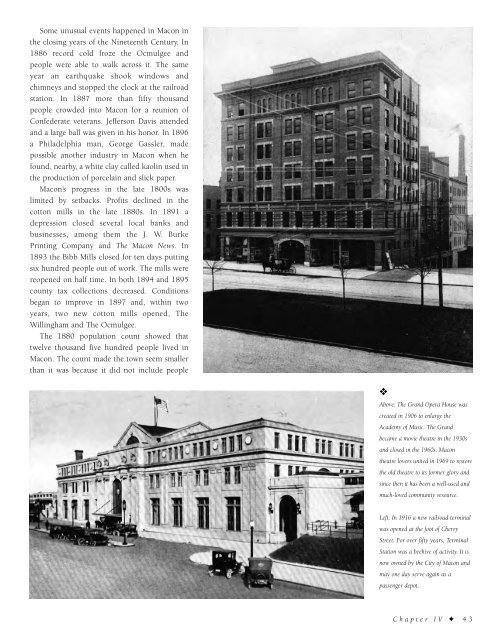Historic Macon
An illustrated history of the city of Macon, paired with the histories of companies, families and organizations that make the region great.
An illustrated history of the city of Macon, paired with the histories of companies, families and organizations that make the region great.
Create successful ePaper yourself
Turn your PDF publications into a flip-book with our unique Google optimized e-Paper software.
Some unusual events happened in <strong>Macon</strong> in<br />
the closing years of the Nineteenth Century. In<br />
1886 record cold froze the Ocmulgee and<br />
people were able to walk across it. The same<br />
year an earthquake shook windows and<br />
chimneys and stopped the clock at the railroad<br />
station. In 1887 more than fifty thousand<br />
people crowded into <strong>Macon</strong> for a reunion of<br />
Confederate veterans. Jefferson Davis attended<br />
and a large ball was given in his honor. In 1896<br />
a Philadelphia man, George Gassler, made<br />
possible another industry in <strong>Macon</strong> when he<br />
found, nearby, a white clay called kaolin used in<br />
the production of porcelain and slick paper.<br />
<strong>Macon</strong>’s progress in the late 1800s was<br />
limited by setbacks. Profits declined in the<br />
cotton mills in the late 1880s. In 1891 a<br />
depression closed several local banks and<br />
businesses, among them the J. W. Burke<br />
Printing Company and The <strong>Macon</strong> News. In<br />
1893 the Bibb Mills closed for ten days putting<br />
six hundred people out of work. The mills were<br />
reopened on half time. In both 1894 and 1895<br />
county tax collections decreased. Conditions<br />
began to improve in 1897 and, within two<br />
years, two new cotton mills opened, The<br />
Willingham and The Ocmulgee.<br />
The 1880 population count showed that<br />
twelve thousand five hundred people lived in<br />
<strong>Macon</strong>. The count made the town seem smaller<br />
than it was because it did not include people<br />
❖<br />
Above: The Grand Opera House was<br />
created in 1906 to enlarge the<br />
Academy of Music. The Grand<br />
became a movie theatre in the 1930s<br />
and closed in the 1960s. <strong>Macon</strong><br />
theatre lovers united in 1969 to restore<br />
the old theatre to its former glory and<br />
since then it has been a well-used and<br />
much-loved community resource.<br />
Left: In 1916 a new railroad terminal<br />
was opened at the foot of Cherry<br />
Street. For over fifty years, Terminal<br />
Station was a beehive of activity. It is<br />
now owned by the City of <strong>Macon</strong> and<br />
may one day serve again as a<br />
passenger depot.<br />
Chapter IV ✦ 43
















